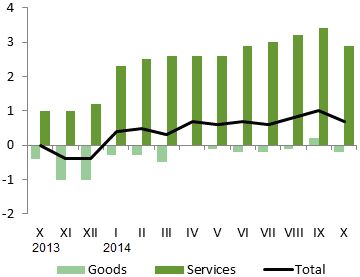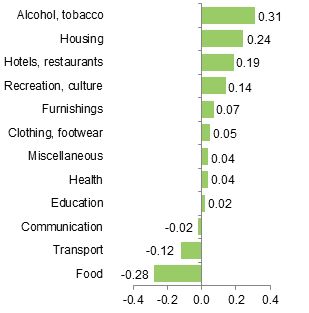Analytics, Inflation, Latvia, Markets and Companies
International Internet Magazine. Baltic States news & analytics
Saturday, 20.04.2024, 05:59
Annual inflation in Latvia constituted 0.7% in October
 Print version
Print version
Prices of goods decreased by 0.2%, while prices of services grew by 2.9%. Compared to the previous 12 months, the average consumer price level over the last 12 months2, increased by 0.5%.
 |
| Changes in consumer prices in 2013 and 2014 (% over the corresponding month of the previous year) |
Data source: Central Statistical Bureau of Latvia
Compared to October 2013, the greatest pressure on the price changes in October 2014 was put by rise in the prices of alcoholic beverages and tobacco, services related to housing, hotel and restaurant services, recreation and culture, as well as by drop in the prices of food and non-alcoholic beverages, transport goods and services.
The average food price level in October 2014 as compared to the corresponding month of the previous year decreased by 1.2%. Lower prices than in the previous year were recorded for milk and dairy products, sugar, meat and meat products, oils and fats, eggs, bread. In turn, growth was recorded in the prices of vegetables, ground coffee, confectionery and honey, and cheese.
 |
| Commodity group impact on Consumer Price Index over the last 12 months (percentage points) |
Prices of tobacco grew by 8.6%, and prices of alcoholic beverages increased by 1.3%.
During the year prices of services related to housing increased by 1.5%. It was influenced by the price growth for maintenance charges in multi-occupied buildings, water supply, maintenance and repair of the dwelling, sewage collection, actual rentals for housing, and solid fuel. In turn, decrease was recorded in the prices of heat energy.
In transport group prices declined by 0.9%, which was significantly affected by a drop of 2.2% in the prices of fuels for transport. Decrease was also recorded for prices of spare parts and accessories for transport vehicles. Growth was observed in the prices of maintenance and repair of personal transport equipment, and of passenger transport by sea.
Compared to October 2013, prices of hotel and restaurant services increased by 4.5%. Prices in cafés and restaurants increased by 4.6%, in canteens – by 4.4%, as well as on accommodation services – by 3.2%.
Among other commodity groups growth was recorded in prices of clothing, goods and services for routine household maintenance, outpatient services and cultural services.
Compared to the previous month, the average level of consumer prices in October 2014 did not change. The average price level of services decreased by 0.2%, whereas of goods rose by 0.1%.
The greatest pressure on the consumer prices during the month was put by drop in the prices of food, recreation and culture, transport goods and services, as well as by growth in the prices of clothing and footwear, services related to housing, individual care goods, alcoholic beverages and tobacco.
Prices of food declined by 0.3%, which, like in September, was affected by drop in the prices of milk and dairy products. Prices of milk decreased by 4.8%, sour cream – by 3.4%, sweet cream – by 2.6%, kefir – by 3.6%, yoghurt – by 5.1%, and curd – by 5.4%. Affected by seasonal factors, there was a drop in the prices of fruit (-3.7%), mainly apples and lemons. Decrease was also recorded in the prices of potatoes, bread and cereals. In turn, growth was observed in the prices of vegetables (+9.5%), mainly cucumbers and tomatoes. Increase was also recorded in the prices of tea and coffee, meat and meat products.
Compared to September, prices of alcoholic beverages increased by 0.7%, which was affected by the end of discounts for wine and beer. Prices of tobacco declined by 0.2%.
Prices of clothing increased by 3.3%, which was affected by goods of the winter season entering the market. In turn, prices of footwear declined by 4.3%.
In transport group prices decreased by 0.3%. It was due to a price drop of 1.3% for fuels for transport.
Over the month, prices of recreational and cultural goods and activities declined on average by 0.5%. The most significant drop was recorded in the prices of package holidays and cultural services.
Influenced by the end of sales campaigns, individual care goods became more expensive.
Among other commodity groups growth was recorded in prices of heat energy, as well as of spare parts and accessories for transport vehicles. In turn, drop was observed in the prices of non-compensated pharmaceutical products and accommodation services.
Consumer price changes by commodity group, %
|
Commodity group |
Price changes in October 2014, compared to |
||
|
October 2013 |
December 2013 |
September 2014 |
|
|
Total |
0.7 |
1.1 |
0.0 |
|
Food |
-1.2 |
-1.2 |
-0.3 |
|
Alcohol, tobacco |
3.8 |
4.9 |
0.4 |
|
Clothing, footwear |
0.8 |
4.0 |
0.9 |
|
Housing |
1.5 |
1.8 |
0.3 |
|
Furnishings |
1.6 |
2.7 |
0.3 |
|
Health |
0.8 |
1.0 |
-0.3 |
|
Transport |
-0.9 |
-1.0 |
-0.3 |
|
Communication |
-0.6 |
-0.6 |
0.2 |
|
Recreation, culture |
1.8 |
1.9 |
-0.5 |
|
Education |
1.5 |
1.5 |
0.0 |
|
Hotels, restaurants |
4.5 |
4.4 |
-0.4 |
|
Miscellaneous |
0.8 |
1.5 |
0.6 |
Sub-indices having the greatest impact, percentage points
|
During the month |
|
|
Clothing |
+0.12 |
|
Vegetables |
+0.11 |
|
Heat energy |
+0.04 |
|
Package holidays |
-0.04 |
|
Fruit |
-0.06 |
|
Fuels for transport |
-0.08 |
|
Footwear |
-0.08 |
|
Milk and dairy products |
-0.09 |
|
During 12 months |
|
|
Tobacco |
+0.24 |
|
Cafés and restaurants |
+0.11 |
|
Maintenance charges in multi-occupied buildings |
+0.10 |
|
Clothing |
+0.09 |
|
Cultural services |
+0.08 |
|
Footwear |
-0.06 |
|
Fuels for transport |
-0.14 |
|
Milk and dairy products |
-0.21 |
More detailed information on consumer price changes is available in the CSB database section Consumer prices.
1 The
annual measure of inflation that is used to compare the average monthly price
level with the average price level in the corresponding month of the previous
year.
2 The average annual
measure of inflation that is used to compare the average price level of the
last 12 months with the average price level in 12 months of the previous year.








 «The Baltic Course» Is Sold and Stays in Business!
«The Baltic Course» Is Sold and Stays in Business!

